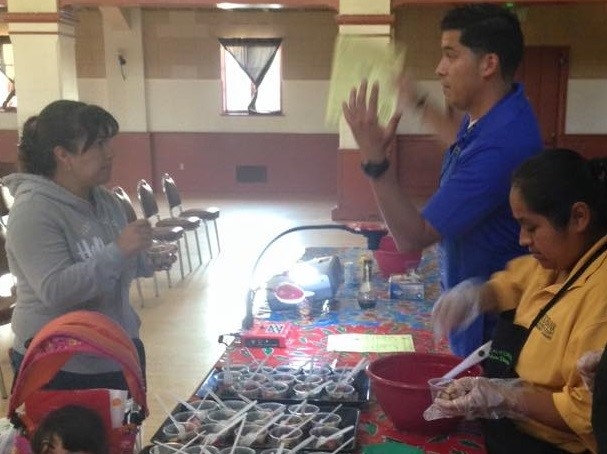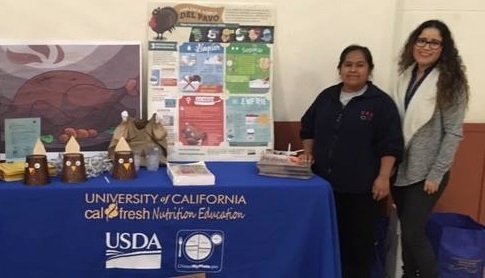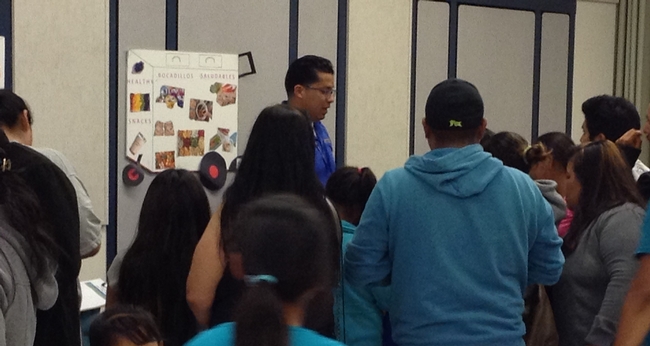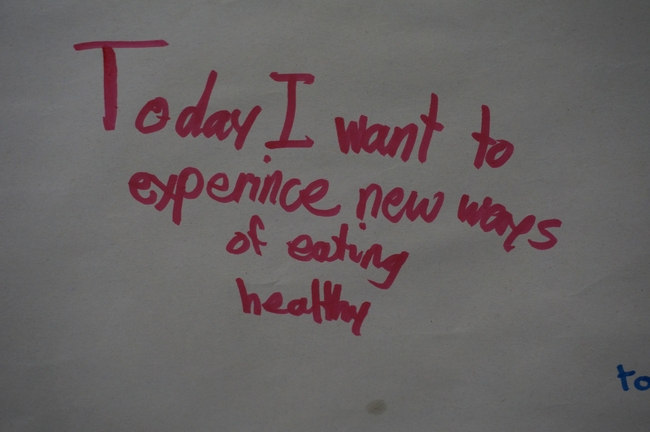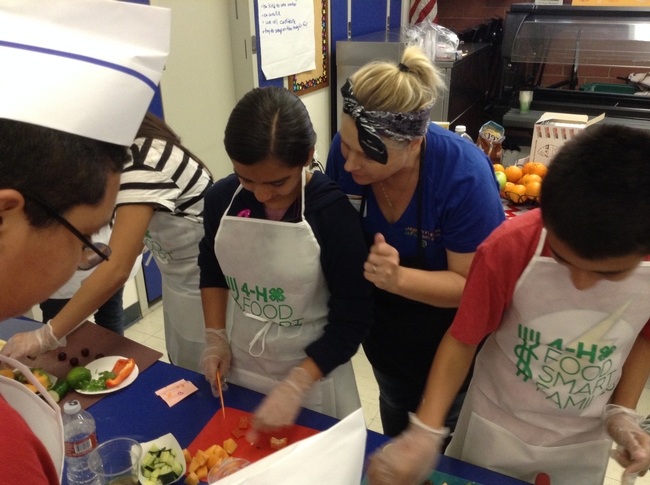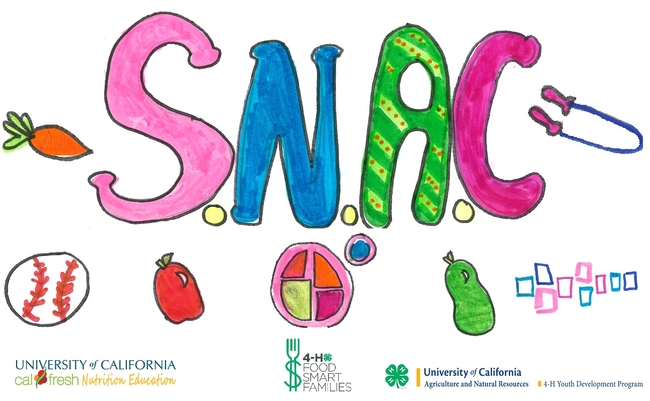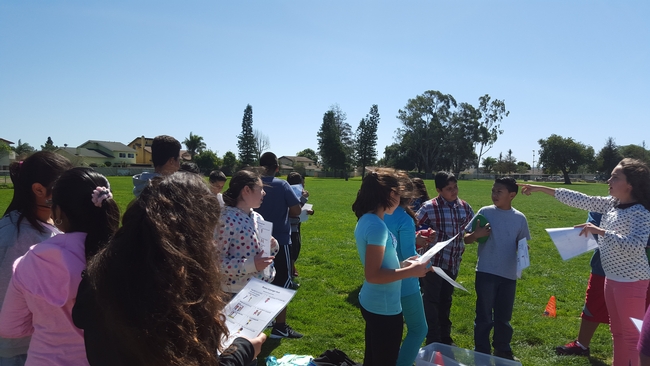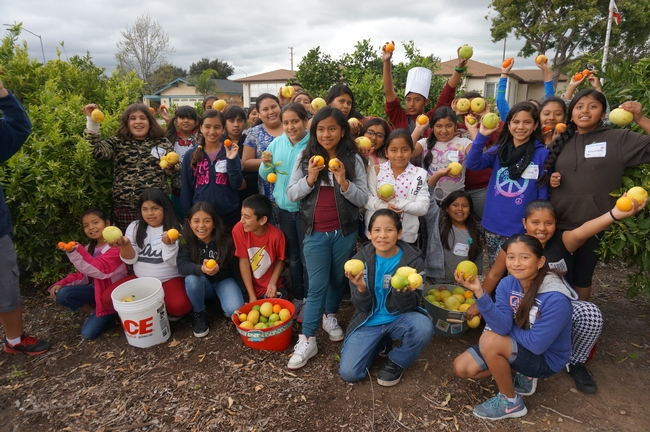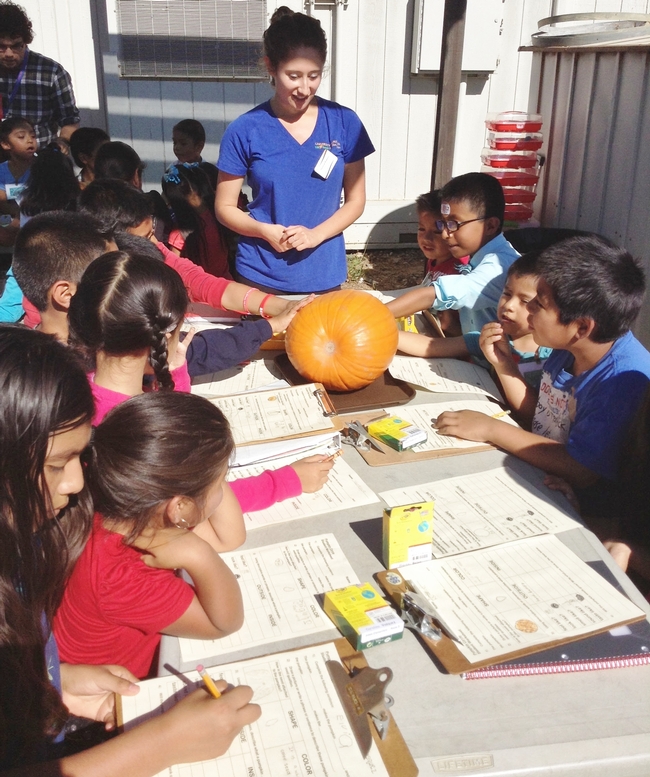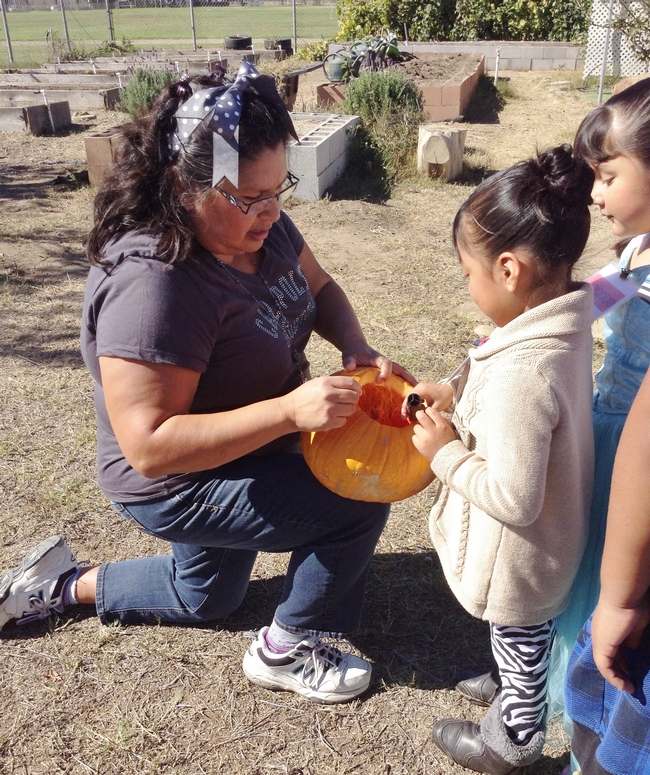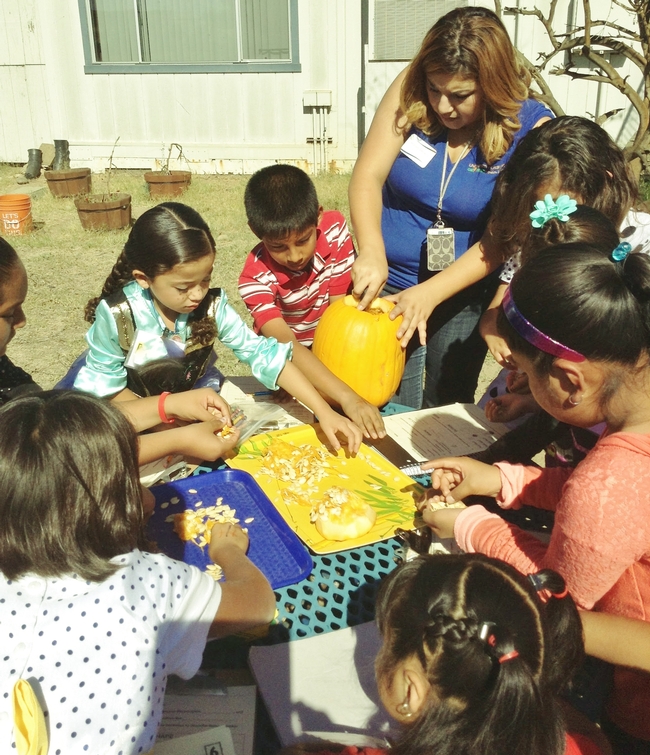Posts Tagged: Santa Barbara
With nutrition education, a conversation may be more fruitful than a lecture
How do we support low-income Latino families with appropriate nutrition education that makes a difference in their lives? This was the question staff with the UC CalFresh Nutrition Education Program in San Luis Obispo and Santa Barbara counties were asking ourselves as we prepared for a monthly presentation at the THRIVE Healthy School Pantry in Santa Maria, California.
While many nutrition education programs work with local food banks to provide food demonstrations and nutrition information at supplemental food distribution sites, often, these classes can feel rushed. People are likely hurrying to pick up their food and so there is little time for more than just one-way communication where the educator provides the information and participants listen. Other times families may feel obligated to stay for the nutrition lesson in order to get their bag of food for their families.
This was the experience of our UC CalFresh Nutrition Educators delivering presentations and recipe demonstrations at the Healthy School Pantry food distribution. The Healthy School Pantry is a monthly food distribution focused on increasing food security and providing a strong social network for families to access a wide variety of community resources in English and Spanish.
When our nutrition education team started working at the Healthy School Pantry, the set-up was similar to a formal classroom environment where there was a teacher and students. The students (in this case, parents and families) would sit in rows, while the nutrition educator stood up front with a projector and microphone providing nutrition messages and a recipe demonstration using food from the pantry. We would include skills for preparing a recipe, and offer food samples and practical tips related to USDA's MyPlate.
After a few of these formal presentations, we began to notice that many parents were not interacting. We would ask for questions or suggestions on how participants could use this information or recipe, and most would respond with silence or politely, “todo está bien, gracias” [“everything is good, thanks”]. We also noticed other families would try to get past our table without making eye contact in order to leave. It became apparent that the families, for various personal or cultural reasons, did not feel comfortable participating and interacting in this formal class setting. Others just did not want to sit and listen for 15 to 30 minutes if they weren't sure that the information was going to be relevant to them.
Taking this into account, we decided to modify our approach. First, we got rid of the microphone and projector and moved our table into a high traffic area more integrated with the other community resources. Next, we changed our presentations to be more participatory and conversational. We set up our table with a colorful display and often a food sample, and then we walked around to the front of the table where we could greet and approach the families without a barrier. At one recent event, we brought an activity wheel and some basic physical activity equipment like jump ropes and stretchy bands. Parents walked right up and started to spin the wheel. When it landed on an exercise they would grab the equipment and start doing the activity and asking for tips. We were so surprised that they wanted to actually do the exercise right then and there and were really interested in talking to us about how they could get more physical activity in their busy lives. At one point we had a long line of parents waiting.
With these small changes, parents are provided more individual attention and an opportunity to have a conversation with the educator rather than feeling like they are students in a classroom. We are able to have more meaningful conversations and the parents are the ones approaching us and asking, “What recipe are you preparing today?” Parents are initiating the conversations and once we engage with them, they have many more questions about the ingredients, where to get them and the dialogue continues in a natural way that is meaningful and relevant to their lives. We are also able to clear up some misconceptions they may have. For example, we have heard many parents say they think that canned or frozen fruits are not healthy. Once we have their trust we are able to clear up the misinformation and let them know that canned and frozen produce can be an economical way to get more fruits and vegetables in their diet and, as long as there isn't added salt or sugar, can be just as healthy as fresh produce.
Within these conversations we take the opportunity to provide nutrition messages and tips, but we also have the opportunity to hear the parents' perspectives and comments. For example, one participant commented on a recipe they were demonstrating saying, “I really like the bean and garbanzo salad because it's nutritious, it has iron, vitamins and it is really easy to make.”
For our larger nutrition education program, this method has brought about additional benefits, including the opportunity to build stronger relationships with parents in the community and to talk to them about what our program is doing with their children during the school day. One mother who had approached our table several times in the past told us, "For me and my family, we have changed a lot about how we eat. We eat healthier and cheaper and we spend less on buying junk food. My children like what they have been taught in their classes by your program. That's why I like it because my children no longer like to eat things that are not healthy.”
Through these conversations, we see that families are leaving our table more informed and are more willing to seek out and approach our table the following month. The level and quality of interaction has increased and we are able to see and hear about the impact of our work and modify or change approaches based on the suggestions from the families.
We will continue with this successful education delivery model because we have seen and heard the satisfaction of the families and have received a lot of great feedback from parents. These small successes that are revealed to us through mutually respectful conversations keep us motivated to continue to provide services and promote a healthier community in a way that respects and values the experiences and knowledge that our families share.
Inspiring youth leaders to cultivate health
What are sixth-graders interested in these days? “Cooking!” “Growing food!” “Learning how to be healthier.” “Exercising.” “Meeting new friends!” These enthusiastic answers came from sixth-grade student leaders in Santa Maria, Calif., when asked by educators from the UC Cooperative Extension Youth, Families and Communities program in San Luis Obispo and Santa Barbara counties.
Through an integrated youth-focused healthy living project, called Food Smart Families, funded by National 4-H, the UC ANR 4-H Youth Development Program, and the UC CalFresh Nutrition Education program, 32 fourth- through sixth-grade student leaders were brought together from three schools in Santa Maria, Calif., for a full-day educational retreat that focused on engaging youth to explore their healthy lifestyle interests and see themselves as leaders.
Throughout the day, student leaders experienced physical activity games, learned cooking skills, participated in garden-based learning, and developed their presentation skills. They focused on skill development, as well as transference so that the student leaders could take these activities into their own schools to encourage and teach their peers. For example, the fun physical activity breaks that were incorporated throughout the day modeled games where no one is “out” or excluded, while moving enough to get heart rates up.
After the retreat, the student leaders brought these activities to their own schools, leading their peers in the games during lunch and recess breaks. During the retreat, the student leaders also got to practice knife safety skills while chopping produce to prepare their own veggie pita pockets and fruit salads. With these skills, the student leaders offered food demonstrations and nutrition lessons to their peers during the following weeks.
In the garden, student leaders learned the basics of growing food and how to lead a garden lesson. Students discussed garden tools and how to use them safely, then planted their own seeds to take home. The garden session ended with a gleaning of the school citrus orchard where students laughed and enjoyed the fresh air and fresh fruits growing around them. In their own school gardens, the student leaders have offered lessons and tastings to their peers.
The retreat culminated with youth presentations. The student leaders worked in teams with students from different schools to generate ideas and artwork for the Student Nutrition Advisory Council (SNAC) logo and t-shirt design. They presented their concepts to the larger group, practicing their presentation skills. The student leaders voted on the designs and a winner was selected to be featured on a t-shirt for SNAC leaders at each of the three schools. The students leaders proudly wear their shirts as they lead healthy living education, advocacy and engagement activities.
By the end of the retreat, the student leaders were excited to take the information and skills back to their schools and start leading. Students shared their plans to help other students be more active during recess, be healthy, and help other kids be healthier too.
“This was the best day I have ever had,” said one of the students.
Since the retreat, the student-led initiatives have been numerous and continually evolving. The sixth-graders have encouraged and trained younger students to become their successors as they move onto junior high. Several students co-authored and starred in a video production called “Get to Know Your Salad Bar.” With educator encouragement, the student leaders developed a script to motivate their peers to try out the salad bar by mixing fruit into their salad to make it sweet or putting lettuce and tomato on your hamburger to make it juicy and crunchy. Beyond leading in their own schools, the student leaders have been working to help their entire community. Many of the student leaders helped organize and conduct game-style nutrition activities at a local food pantry distribution to teach families about shopping for healthy foods on a limited budget. Other student leaders provided education and training to students at neighboring schools, encouraging them to become leaders as well.
Through the efforts of the Food Smart Families program, the Youth, Families, & Communities program in San Luis Obispo & Santa Barbara counties merged the strengths of the UC CalFresh Nutrition Education program and the UC ANR 4-H Youth Development program to provide new opportunities and experiences for students in this community. With interested and caring adults, these student leaders learned to share their passions for cooking, gardening, and healthy lifestyle with their peers at school and others in their community. The rewards for the school, community and adult allies continue to expand as these inspired student leaders, with strong mentorship and support, take on some of the biggest challenges facing our society and world.
Planting the seeds for garden-based education
The UC CalFresh Nutrition Education Program in Santa Barbara County (UC CalFresh) is planting new ideas and possibilities to increase teacher use of school gardens.
Each school day, teachers must carefully plan and account for their instructional minutes. For each grade level has specific time recommendations for math and English language arts, so teachers often feel they do not have the time to include extra activities in their already packed schedules. When UC CalFresh gave a brief survey to teachers a Santa Maria school last year, teachers identified the following barriers to using their school garden for instruction:
- Lack of instructional time or preparation time
- Lack of curriculum and learning activities
- Too many students to manage in the outdoor setting
These concerns reflected comments that UC CalFresh nutrition educators frequently heard from teachers who were invited to bring their students to the school garden.
Taking these concerns into consideration, UC CalFresh developed innovative strategies to meet the needs of school teachers, showing how instructional minutes in the garden don't have to be “extra” and can include hands-on learning for English language arts and math, with a focus on nutrition. The strategies include:
- Clearly aligning garden-based nutrition education with common core lessons
- Providing garden-based curriculum and materials for learning activities in the garden
- Hosting Garden Open House Days, during which teachers can bring their students to the garden when UC CalFresh Educators are present to increase educator-to-student ratios.
To meet the needs of partnering teachers, UC CalFresh educators developed “No-Prep Nutrition Education Kits,” enabling teachers to teach common core-aligned nutrition education lessons without having to use prep time to make copies or create materials of their own. This year, based on the survey data, UC CalFresh expanded the No-Prep Nutrition Education Kits to include lessons that could be taught in the garden.
The first No-Prep Garden-Based Nutrition Education Kit was piloted in October and featured pumpkins. The No-Prep Kit became fondly known as the Pumpkin Kit. The Pumpkin Kit encouraged teachers to take the lesson out to the garden, increasing students' physical activity time while providing opportunities for students to practice common core skills. The kit focuses on nutrition and cooking while reinforcing math, science and language arts. The kit includes books, worksheets, an oven, and several different pumpkins for measuring, cooking, estimating, and tasting. This kit requires no teacher prep time, is adaptable to any primary grade level, and is an easy introduction to garden-based lesson delivery.
During a Garden Open House Day hosted by UC CalFresh in October, kindergarten students and their fifth-grade buddies came out to the garden. The fifth-grade buddies worked with the kindergarten students to use observation skills (five senses), learn adjectives, and draw the pumpkin life cycle. The older buddies gained teaching and language arts skills while working with their little buddies in the garden. Students got to dissect the pumpkins in teams and used the seeds for counting. Each kindergartener took 20 seeds home to practice counting with their parents, which also served as a budding connection for students' families and the school garden.
"If we had something like this every month, we would be able to go out into the garden more and maybe we could get more teachers to come. This is what we need, curriculum that can be used in the garden," said kindergarten teacher Mrs. Joaquin.
Moving forward, UC CalFresh is piloting bimonthly No-Prep Kits for garden-based lessons, featuring the USDA's DigIn! curriculum, as well as other UC curricula. Teachers can teach with the kits on their own in the garden or come during UC CalFresh hosted Garden Open House Days for extra educator support. By easing teachers' paths into the garden, students get to spend time outdoors, engage in physical activity, and participate in learning that reinforces their science, English language arts and math skill development.
“The program has been awesome," said one fourth-grade teacher. "[UC CalFresh] incorporated math, science, social studies into lessons. Students were excited and engaged. Many tried new vegetables they'd never had before and liked them! Kids learned responsibility and pride in designing, choosing plants, maintaining and harvesting in school garden.”
For more on UC CalFresh of San Luis Obispo and Santa Barbara counties see the Facebook page at facebook.com/uccalfreshslosb
UC CalFresh nutrition education is offered in schools jointly by UC Agriculture and Natural Resources and USDA.
Santa Barbara funds CE; Faulkner Farm supporters write letters to editors
The Santa Barbara County Board of Supervisors voted unanimously Tuesday to save the local UC Cooperative Extension programs by approving additional funding, according to the Aug. 11 Lompoc Record.
“State cuts to the UC system, combined with local funding reductions, would have reduced the Extension program’s presence in Santa Barbara County to practically nothing without the infusion of cash from the Board of Supervisors,” writes reporter Sam Womack.
In other South Coast news, Ventura County residents have been writing letters to the editors of the Ventura County Star and the Santa Paula Times voicing opposition to the Hansen Trust Advisory Board’s recommendation to sell Faulkner Farm.
In the Aug. 9 Ventura County Star, Douglas Nelson and Nicholas Deitch of Mainstreet Architects + Planners write that they were hired by UC to provide a Master Plan for the Hansen Agricultural Center at Faulkner Farm.
“We worked for over a year with the first Hansen Trust Advisory Board, UC staff, UC Cooperative Extension and design focus groups from the local community,” they wrote. “Through a collaborative process, we developed a long-range plan for the Hansen Trust - a plan that was based on principles and goals reflecting the vision of benefactor Thelma Hansen.” They call the recommendation to sell Faulkner Farm “a very short-sighted decision.”
In the Aug. 6 Santa Paula Times (available only in print form currently), Mike Mobley and Ginger Gherardi of Santa Paula urge readers to “help in preventing this travesty by writing a letter” to President Yudof and VP Dooley.
Santa Barbara supervisors express support for UCCE
The Santa Barbara County Board of Supervisors on July 27 said it intends to keep UC Cooperative Extension in Santa Barbara County, according to the Lompoc Record.
All five supervisors expressed support, but requested contract language detailing the number of university academics dedicated to the county, and clarity in where the additional funding for a total of $180,000 would come from. They will meet on Aug. 10 to make a final decision on the funding, which would ensure UC Cooperative Extension programs continuing in Santa Barbara County.
On June 22, the board didn’t have enough votes to approve funding, but later decided to reconsider the proposal, according to an article in the Santa Ynez Valley News.

